Text
Philippine Traditional Art

Kulintang from Mindanao
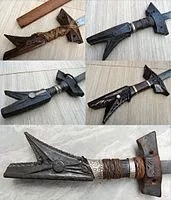
Kampilan Hilts
Carving or Wood Carving
Indigenous woodcarving is one of the most notable traditional arts in the Philippines, with some crafts in various ethnic groups date back prior to Hispanic arrival with perhaps the oldest surviving today are fragments of a wooden boat dating to 320 AD. Many societies utilize a variety of woods into making wood crafts such as sacred bulul figures
0 notes
Text
Philippine Traditional Art
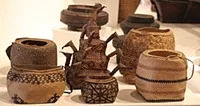
Various Rice Basket
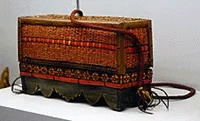
Filipino Tobacco Basket
Basketry
The fine art of basket weaving in the Philippines has developed intricate designs and forms directed for specific purposes such as harvesting, rice storage, travel package, sword case, and so on. The art is believed to have arrived in the archipelago due to human migration, where those in the north were the first to learn the art form. The finest vessel basket crafts made, however, comes from the ethnic groups of Palawan, in the southwest. The Batak of Palawan has utilized the craft into high art, as well as retaining their craft's status as functional art. Intricate basketry can also be found among the Mamanwa, various Negrito groups, Mangyans, Ivatan, and many others.
0 notes
Text
Philippine Traditional Art
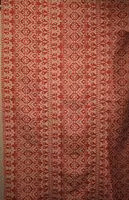
Binakol

T'nalak
Weaving
Weaving is an ancient art form that continues in the Philippines today, with each ethnic group having its distinct weaving techniques. The weaving arts are composed of basket weaving, back-strap loom weaving, headgear weaving, fishnet weaving, and other forms of weaving.
Cloth and mat weaving
Expensive textiles are made through the intricate and difficult process called back-strap looming. Fibers such as Cotton, abaca, banana fiber, grass, and palm fiber are used in the Filipino weaving arts. There are many types of weaved clothes in the Philippines. Pinilian is an Ilocano cotton cloth weaved using a pangablan, where weaving styles of binakul, binetwagan, or tinumballitan are inputted. Bontoc weave revolves around the concept of centeredness, a key cultural motif among the Bontoc people. In its weave, the process starts with the sides called langkit until it journeys into the pa-ikid (side panels), fatawil (warp bands), and shukyong (arrows). Afterwards, the sinamaki weaving commences, where the tinagtakho (human figure), minatmata (diamond), and tinitiko (zigzag) are incorporated. The last is center, pa-khawa, which features the kan-ay (supplementary weft).
0 notes
Text
Philippine Traditional Art

A balangay reconstruction
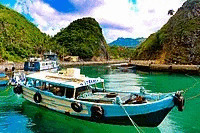
A modernized falua in Batanes
Maritime Transport
Maritime transport in the Philippines includes boat houses, boat-making, and maritime traditions. These structures, traditionally made of wood chosen by elders and crafts folks, were used as the main vehicles of the people, connecting one island to another, where the seas and rivers became the people's roads. Although boats are believed to have been used in the archipelago for thousands of years since the arrival of humans through water, the earliest evidence of boat-making and the usage of boats in the country continues to be dated as 320 AD through the carbon-dating of the Butuan boats that are identified as remains of a gigantic balangay
0 notes
Text
Philippine Traditional Art

A Simple Bahay Kubo

Bahaykubo-style Mabini House
Folk Architecture
Folk architecture in the Philippines differs significantly per ethnic group, where the structures can be made of bamboo, wood, rock, coral, rattan, grass, and other materials. These abodes can range from the hut-style Bahay Kubo which utilizes vernacular mediums in construction, the highland houses called bale that may have four to eight sides, depending on the ethnic association, the coral houses of Batanes which protects the natives from the harsh sandy winds of the area, the royal house torogan which is engraved with intricately-made okir motif, and the palaces of major kingdoms such as the DaruJambangan or Palace of Flowers, which was the seat of power and residence of the head of Sulu prior to colonization
0 notes
Text
Philippines

Philippines, island country of Southeast Asia in the western Pacific Ocean. It is an archipelago consisting of some 7,100 islands and islets lying about 500 miles (800 km) off the coast of Vietnam. Manila is the capital, but nearby Quezon City is the country’s most-populous city. Both are part of the National Capital Region (Metro Manila), located on Luzon, the largest island. The second largest island of the Philippines is Mindanao, in the southeast.
0 notes
Text
Filipino Traditional Language
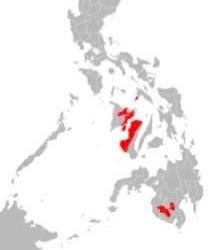
Hilagaynon
Hiligaynon or Ilonggo is the language used in Aklan, Antique, Bacolod, Capiz, Iloilo, Panay Islands as well as in North and South Cotabato in Mindanao. This language is distinct for having a sweet intonation. And as of 2000, there were 7,000,979 sweet speaking Filipinos in the country.
Example:
Good morning – Maayo nga Aga
Good evening – Maayo nga Hapon
Goodbye – Asta sa liwat
0 notes
Text
Filipino Traditional Language

Ilocano
Ilokano or Ilocano is a combination of other languages from other countries such as Chamorro of Guam, Indonesian, Hawaiian, Malay, Samoan and Tahitian. It is mostly spoken in the Northern part of the country but because Ilocano speaking people have spread throughout the Philippines, it ranked as third of the most spoken language with 7,779,000 Filipinos using it.
Example:
Good morning – Naimbag a bigat
Good evening – Naimbag a sardam
I love you – Ayayatenka
0 notes
Text
Filipino Traditional Language
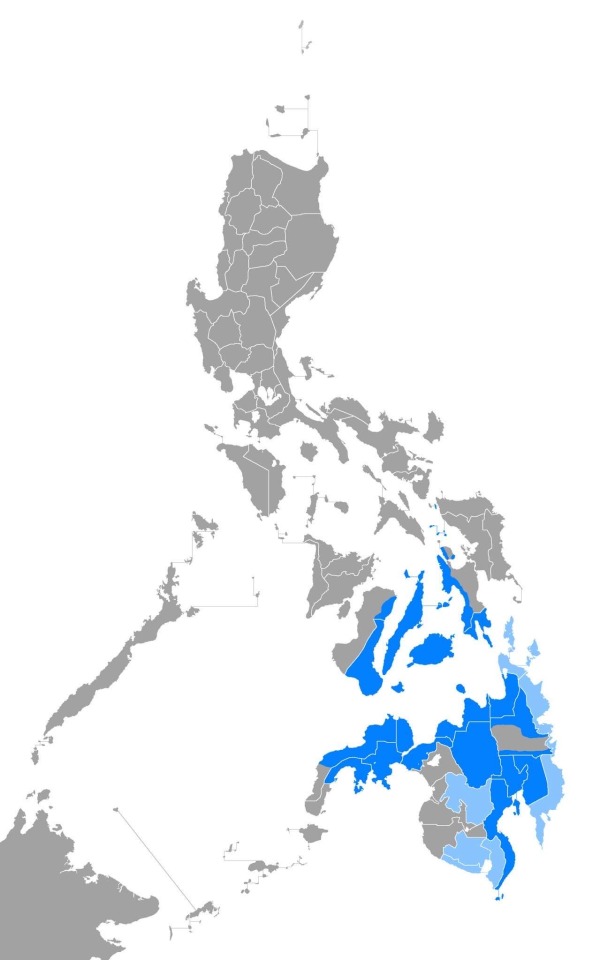
Cebuano
Cebuano is the next most spoken language in the Philippines with a total of 21,340,000 Filipinos using it. This is mainly used in Cebu City and some areas in Mindanao, such as Butuan, Cagayan de Oro, Davao, and General Santos City.
Example:
Good morning – Maayong buntag
Good evening – Maayong gabii
I love you – Gihigugma ko ikaw
0 notes
Text
Filipino Traditional Language

Tagalog
Our national language was based from Tagalog. It is used mainly in Manila Area and nearby provinces such as Batangas, Bulacan, Cavite, Nueva Ecija, and Laguna. This is the only Filipino language that is generally used and can be understood around the country. Based on the Philippine census conducted by the Philippine Statistics Authority, there were 26,387,855 Filipinos who speak this language in the country.
0 notes
Text
Filipino Traditional Beliefs

Pagpag
Don’t go straight home after attending a wake it is called "pagpag" in English the shaking off of dirt, because many Filipino believe that if you go straight to your house the spirit of the dead person comes with you. And if you don't want to follow you go to the place that has a lot of people.
0 notes
Text
Filipino Traditional Festival
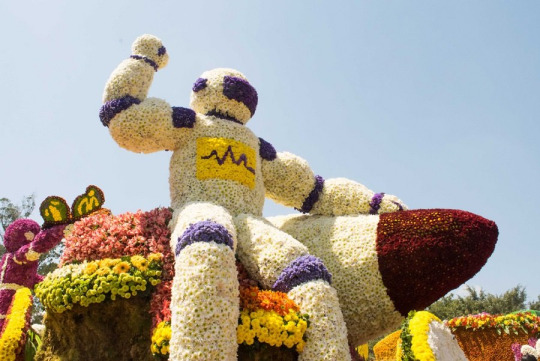
Panagbenga Festival- Baguio City
Panagbenga is a local Kankana-ey term in Cordillera, which means “a season for blossoming.” Panagbenga Festival is a month-long festival in Baguio. Tourists flock to the city during this time to watch the Grand Float Parade which features giant floats in different characters made of flowers. Many celebrities also perform here. Because of this, Panagbenga has become a famous festival in the Philippines.
0 notes
Text
Filipino Traditional Festivals

Pahiyas Festival - Lucban, Quezon
Every famous festival in the Philippines is always colorful, and Pahiyas Festival, without a doubt, is one of the most colorful and vibrant festivals in the Philippines. You can trace the Pahiyas Festival origin way back in the 15th century. Farmers then used to offer their harvests at the foot of Mount Banahaw.
This is an annual celebration to pay homage to San Isidro Labrador, the patron saint of farmers, for a bountiful harvest in town. Houses are decorated with the town’s best agricultural products, mostly colorful Kipings— a traditional Filipino leaf-shaped wafer made from glutinous rice.
What’s more exciting about Pahiyas festival is that FREE and grab-all-you-can fresh fruits and vegetables are everywhere for the visitors to taste and enjoy.
1 note
·
View note
Text
Filipino Traditional Festivals

Dinagyang Festival - Ilo-Ilo City
Dinagyang is a Hiligaynon word that means “merrymaking.” Just like the Sinulog and Ati-Atihan Festivals, Dinagyang is one of the religious festivals in the Philippines that celebrates the feast of the Santo Niño and the pact between the Datus and locals.
Every 4th Sunday of January, the festival transforms Iloilo City into a massive street party with overflowing drinks and food. The most exciting part is that the city hosts a highly competitive street dancing contest that features tribes, represented by the locals.
0 notes
Text
Filipino Traditional Festivals
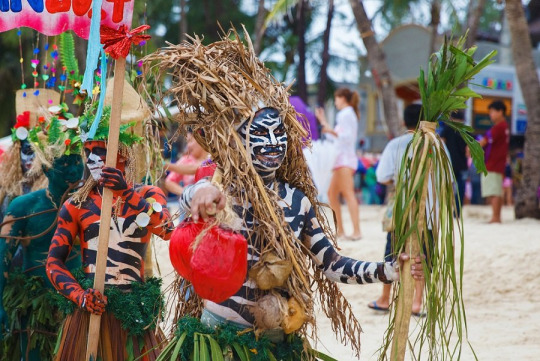
Ati-Atihan Festival - Aklan
If you plan to visit Boracay in January, you might as well watch the locals masquerading as Negritos in colorful costumes, dancing and chanting “Hala Bira!” in Aklan for their Ati-Atihan Festival.
Similar to Cebu’s Sinulog Festival, this event is celebrated to honor Santo Niño. Ati-Atihan Festival in Aklan is considered to be one of the best festivals in the Philippines. This religious festivity is also one of the oldest Philippine celebrations.
0 notes
Text
Filipino Traditional Festivals

Sinulog Festival - Cebu
Head down south to the Queen City and experience this fiesta in the Philippines that celebrates Cebu’s patron saint— Santo Niño. This is a week-long event that is done with processions, parties, concerts, colorful and lively street dancing, irresistible drum beats, and parades.
The word “Sinulog” means “like the water current,” and is actually the name of the step that the dancers perform.
0 notes
Text
Filipino Traditional Clothes

Igorot clothing
One of the native Filipino tribes (from the northern Philippines) wears this costume for their daily activities. More accessories are used for special occasions. Generally, it is called “tapis.” It is simply wrapped around the waist. Often, a threat is used to secure it from falling off. It is a large rectangular woven clothing that measures 3-4 feet long and 3-5 feet wide.
0 notes